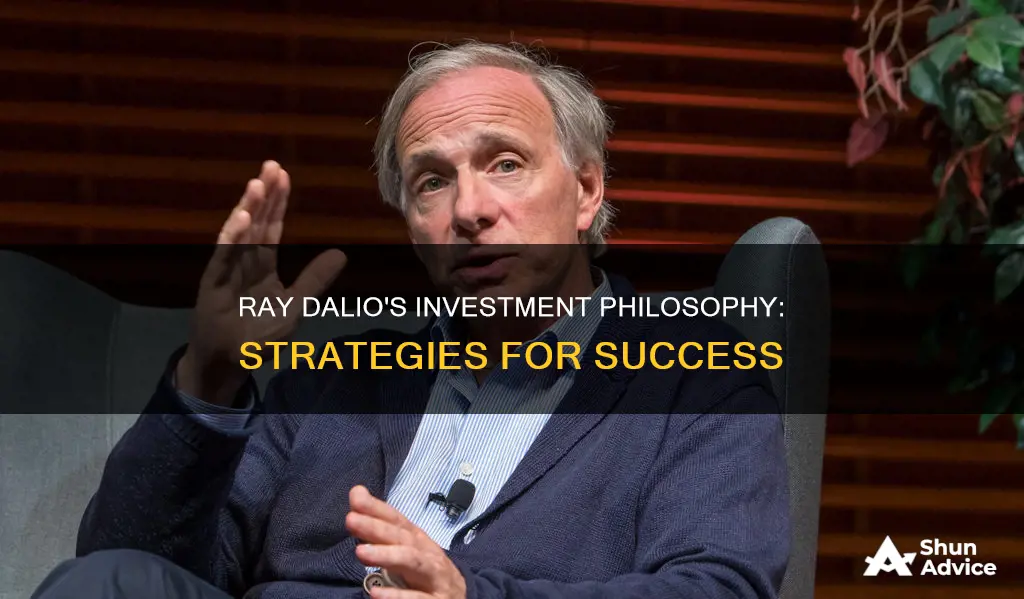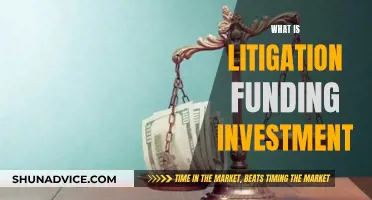
Ray Dalio is an American billionaire investor and hedge fund manager. He is the founder of Bridgewater Associates, the world's largest hedge fund, which manages about $150 billion in assets. Dalio's investment strategy is based on five key themes, including a focus on macroeconomic trends, a healthy respect for inflation, diversification across 15 or more uncorrelated assets, taking profits on fully priced stocks, and acknowledging and addressing biases.
Dalio's most famous investment strategy is the All-Weather portfolio, which aims to perform well in all economic environments. The portfolio is constructed using risk parity weightings for stocks, bonds, and commodities, with an emphasis on reducing risk and maintaining a balanced, structured portfolio.
While Dalio's investment strategies have been highly successful, it's important to note that his exact investment portfolios are largely kept secret.
| Characteristics | Values |
|---|---|
| Founder | Ray Dalio |
| Type of fund | Hedge fund |
| Largest hedge fund in the world | Yes |
| Year founded | 1975 |
| Ray Dalio's role | Co-chief investment officer |
| Ray Dalio's net worth | $20 billion |
| Assets under management | $150 billion |
| Bridgewater Associates' top stock and fund holdings in 2024 | iShares Core S&P 500 ETF (ticker: IVV); iShares Core MSCI Emerging Markets ETF (IEMG); Alphabet Inc. (GOOGL); Procter & Gamble Co. (PG); Meta Platforms Inc. (META); Johnson & Johnson (JNJ); Costco Wholesale Corp. (COST) |
What You'll Learn

Ray Dalio's investment strategy
Ray Dalio is a billionaire investor and founder of the world's largest hedge fund, Bridgewater Associates. Dalio's investment strategy is based on a set of principles he has developed over the years, which he has shared through speeches, memos, and his 600-page bestseller, 'Principles'. Here is an overview of his investment strategy:
- Cause-and-Effect Relationships: Dalio believes that cause-and-effect relationships exist almost everywhere, and understanding these relationships can lead to profitable investment opportunities. For example, when investing in commodities like soybeans and corn, he would consider factors such as demand, supply, and external influences to predict future price movements.
- Diversification: Dalio considers diversification as the holy grail of investing. He recommends diversifying across 15 or more uncorrelated assets to reduce risk without sacrificing significant returns. By combining uncorrelated assets, investors can manage risk more effectively.
- Economic Cycles: Dalio's investment strategy also considers the long-term cycles that economies and financial markets experience. He believes that understanding these cycles is crucial for successful investing. He identifies short-term and long-term debt cycles and their impact on markets.
- Open-Mindedness: Dalio emphasises the importance of being radically open-minded and avoiding biases. He acknowledges a past mistake where he lost a significant amount of money by betting against the market due to his biased expectations of an economic downturn.
- Strategic Asset Allocation: Dalio is a proponent of strategic asset allocation, which involves building a portfolio based on target allocations for different asset classes and regularly rebalancing it. He believes that a well-diversified portfolio across various asset classes, such as stocks, bonds, and commodities, is crucial for long-term success.
- Risk Parity: Dalio pioneered the risk parity approach, which aims to improve upon traditional strategic asset allocation by setting asset class weightings based on their contribution to overall portfolio risk. This typically leads to lower exposure to stocks and higher exposure to bonds.
- All-Weather Portfolio: Dalio created the All-Weather Portfolio in the mid-1990s to perform well in various economic environments. It consists of 40% long-term US Treasuries, 30% US stocks, 15% intermediate-term US Treasuries, 7.5% gold, and 7.5% other commodities. This portfolio is designed to withstand different market conditions and has been successful over the long term.
- Long-Term Vision: Dalio advocates for investing with a long-term time horizon rather than focusing on short-term gains. He believes in proper planning to increase returns and minimise losses.
- Avoiding Biases: Dalio believes that investor biases contribute significantly to investment losses. He recommends periodically analysing investment decisions and keeping an investment journal to identify and mitigate biases.
Overall, Ray Dalio's investment strategy revolves around understanding cause-and-effect relationships, diversifying investments, recognising economic cycles, being open-minded, utilising strategic asset allocation and risk parity, and adopting a long-term perspective while avoiding biases.
Strategies for Investing in SoftBank Funds: A Guide
You may want to see also

Dalio's macro perspective
Ray Dalio is a billionaire investor known for his macro investing strategies. Dalio's macro perspective is underpinned by his understanding of the economy as a machine that operates in cycles. He believes that by understanding these cycles, investors can make better decisions and navigate economic shifts.
A key principle of Dalio's macro perspective is diversification. He advocates for diversifying across 15 or more uncorrelated assets to reduce risk without sacrificing returns. In practice, this means investing in different asset classes, such as stocks, bonds, real estate, and commodities, which don't move in the same way during economic shifts.
Dalio also emphasises the importance of understanding long-term economic cycles, such as periods of expansion and contraction, and their impact on different asset classes. He believes that riding these long-term waves is more effective than constantly trying to time the market.
Another aspect of Dalio's macro perspective is his belief in radical transparency and openness. He encourages investors to be radically open-minded, avoiding biases, and accepting when they are wrong. This openness, combined with a systematic approach to decision-making, helps investors make more informed choices and adapt to changing market conditions.
Overall, Dalio's macro perspective is characterised by a deep understanding of economic cycles, a focus on cause-and-effect relationships, a commitment to diversification, and a systematic and transparent approach to investing. By applying these principles, he has achieved remarkable success as a global macro investor.
A Beginner's Guide to Mutual Fund Investing
You may want to see also

Inflation and gold
Ray Dalio is a billionaire investor and founder of the world's largest hedge fund, Bridgewater Associates. Dalio has a healthy respect for inflation and its ability to erode purchasing power and harm investment returns. He advocates for holding gold as an alternative source of money and a hedge against inflation and default risks. Gold is a non-debt-backed form of money, and its value is supported by the risks of debt defaults and inflation.
Dalio's signature allocation for managing wealth during troubled economic times is the All Weather portfolio, which contains a 7.5% allocation of gold. Bridgewater also holds gold funds, as well as stocks of gold miners and producers. SPDR Gold Shares (GLD), a gold ETF, is Bridgewater's 19th-largest position overall, with a 1% allocation.
Gold has been on a record-setting run in recent weeks, with investors keen to buy the precious metal amid the looming risk of recession, elevated inflation levels, and fears of geopolitical turmoil.
Dalio's investment philosophy is based on five key themes, including a healthy respect for the dangers of inflation and a focus on macroeconomic trends. He believes that cause-and-effect relationships exist almost everywhere and that understanding these can inform investment decisions. He also emphasizes the importance of diversification, recommending a mix of 15 or more uncorrelated assets to reduce risk without sacrificing returns.
Dalio's All-Weather Portfolio, designed to perform well in all economic environments, includes a 7.5% allocation to gold and other commodities. This portfolio has historically returned slightly less than the S&P 500 but with lower volatility and better performance during economic downturns.
A Guide to Investing in Bridgewater's Alpha Fund
You may want to see also

Diversification and risk
Diversification is key to Ray Dalio's investment strategy. Dalio is a big proponent of diversification, which he views as the "Holy Grail of Investing". He recommends diversifying across 15 or more uncorrelated assets to reduce the risk-to-return ratio.
Uncorrelated assets do not move together, either directly or inversely. For example, gold and the S&P 500 have a low correlation; the S&P 500 can crash without affecting gold spot prices. By selecting assets that have little or no correlation, investors can protect their portfolios from the risks associated with correlated assets, without sacrificing returns.
Correlation refers to the rate at which assets change in value relative to each other. Positively correlated stocks increase at the same time, while negatively correlated stocks move in opposite directions. Stocks that have no relationship whatsoever have a correlation of zero. Their change in value is influenced by completely different variables, and they move completely independently.
An example of strong correlation can be found by looking at stocks in the same industry. A change in legislation that is unfavorable to financial services providers may cause the value of both Bank of America stock and JP Morgan stock to decline. On the other hand, healthcare stocks as a group are considered a smart choice because increasing demand for healthcare services boosts revenue across the board.
Choosing negatively correlated stocks gives you some stability. When one goes up, the other goes down, protecting the overall value of your portfolio. An example is the negative correlation between oil prices and airline stocks. As fuel is one of the biggest expenses for airline companies, a rise in oil prices can drive airline profits and subsequently stock prices down.
Dalio's All Weather portfolio is a collection of investments carefully designed to survive any market turbulence. It includes long-term bonds, stocks, commodities, gold, and intermediate-term bonds. This mix can withstand pressure regardless of external economic conditions.
Dalio's experience trading currencies and commodities led him to focus Bridgewater on "global macro" investment: investing in a wide range of assets globally and trying to profit from broad macroeconomic and political trends.
A Beginner's Guide to Mutual Fund Investing with $500
You may want to see also

Dalio's All-Weather portfolio
The All-Weather portfolio is an investment strategy developed by Ray Dalio, the founder of Bridgewater Associates, one of the largest hedge funds in the world. The All-Weather portfolio is designed to be a globally diversified portfolio that can perform well in various market conditions, hence its name. The portfolio is intended to be relatively simple and easy to implement and manage for the average investor, with a mix of stocks, bonds, commodities, and currencies.
Core Principles
The core of the All-Weather portfolio is a combination of 30% stocks, 40% long-term bonds, 15% intermediate-term bonds, and 15% commodities. The specific investments within each category can vary, but the overall allocation is meant to be relatively stable over time, which could be achieved through regular rebalancing.
One of the fundamental principles behind the All-Weather portfolio is the idea of "risk parity," which seeks to balance risk across different asset classes rather than maximising returns from any particular asset. The goal is to create a portfolio that can weather market volatility and produce consistent returns over the long term.
Performance
As of October 19, 2024, the Ray Dalio All-Weather portfolio returned 8.29% year-to-date and 5.35% annualised return over the last 10 years. The portfolio has an expense ratio of 0.19%, which is considered low compared to other funds.
The All-Weather portfolio has a Sharpe ratio of 2.33, indicating that its risk-adjusted performance is in line with the majority of portfolios. This suggests a balanced approach to risk and return, suitable for a broad range of investors.
Implementation
The easiest way to replicate the All-Weather portfolio is through a selection of low-cost ETFs, such as:
- 40% TLT (Long-Term U.S. Bonds)
- 15% IEI (Intermediate-Term U.S. Bonds)
- 7.5% DBC (Commodities Index)
- 30% VT (Vanguard Total World Stock Market ETF)
The weightings of these ETFs may be adjusted slightly to better match the desired asset allocation.
The All-Weather portfolio is a well-diversified, low-risk portfolio designed by Ray Dalio to perform well in any economic environment. It has provided stable returns with smaller drawdowns during major crises compared to traditional portfolios. While it may give up some growth potential, it offers more consistent returns with lower volatility, making it suitable for investors seeking capital preservation and a simple investment strategy.
Emergency Fund Strategies: UK Investment Options for Peace of Mind
You may want to see also







